Hey readers, welcome to the colorful world of Bhil Art, where dots, lines, and stories jump straight from tribal village walls onto the fashion streets! If you think tote bags are just for groceries, think again, because now, Bhil Art on Canvas Bags is making heads turn in designer boutiques worldwide. Fun fact: Did you know that India’s handloom and handicraft exports grew by nearly 17% in 2023? That’s proof our traditional art isn’t just surviving; it’s thriving with style!
The Bhils, one of India’s oldest tribal communities, originally painted their huts and walls with vibrant dots and animal motifs to narrate stories of daily life. Today, those same patterns are reimagined on eco-friendly canvas bags that are not only trendy but also sustainable. So next time you carry one, you’re not just holding a bag, you’re carrying centuries of tradition with a chic twist. Ready to explore how these tribal tales became fashion statements? Let’s dive in!
The Origins of Bhil Art in India’s Tribal Villages
If you’ve ever been mesmerized by a canvas full of colorful dots, chances are you’ve already met Bhil Art without even knowing it! This vibrant tribal art form comes from the Bhil community, one of India’s largest and oldest tribes, spread across Madhya Pradesh, Rajasthan, Gujarat, and Maharashtra. Traditionally, Bhils used natural pigments, leaves, and clay to paint the walls of their mud huts. Each dot, motif, and symbol told stories; whether it was about a successful harvest, a hunting adventure, or a festival celebration.
Here’s the fun part: these paintings weren’t just “art for art’s sake.” They acted like illustrated diaries. Imagine Instagram stories, but instead of disappearing in 24 hours, they stayed on the walls for generations! No wonder anthropologists say tribal art is one of the purest forms of storytelling. In fact, according to the Ministry of Tribal Affairs, nearly 8% of India’s population belongs to tribal communities, and many of their art forms like Bhil painting are being preserved through exhibitions and cultural fairs.
How Folk Motifs Are Finding New Life in Urban Fashion
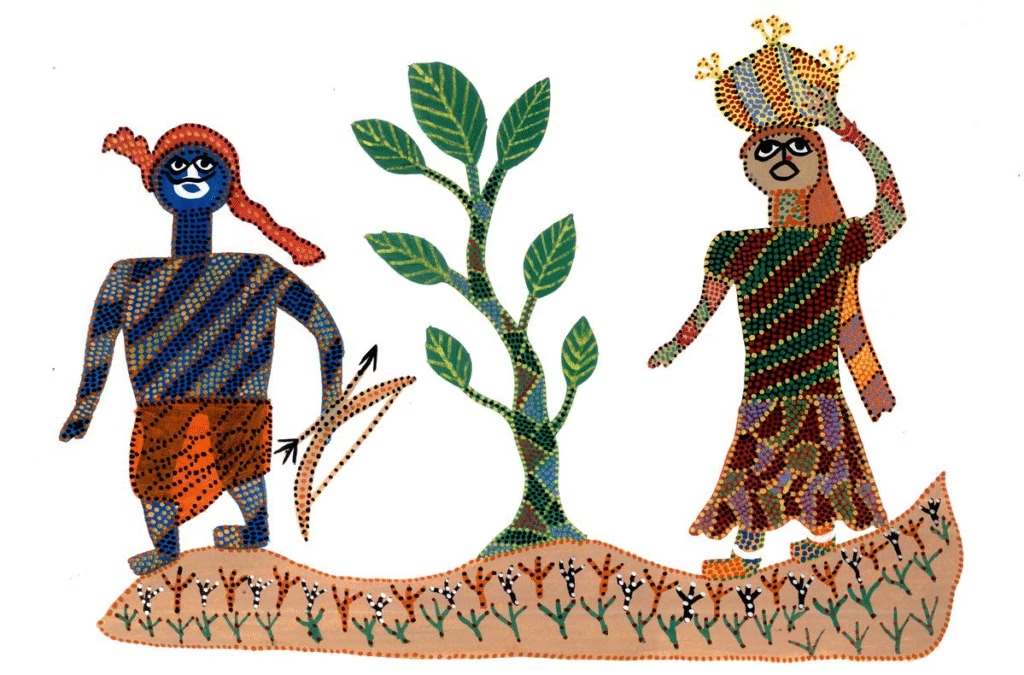
The journey of Bhil Art didn’t stop at the walls of tribal homes; it packed its colors, dots, and stories and marched straight into the world of modern fashion. Today, these motifs are no longer just part of folklore; they’re making waves in designer studios and urban boutiques. Here’s how:
- From Walls to Wardrobes- Bhil motifs once decorated mud walls in villages, but today, they’ve been reimagined on bags, clothes, and accessories. Designers are transforming dots and animal figures into chic fashion patterns, giving Bhil Art a global stage. Imagine carrying a tote that looks stylish and yet whispers ancient folk tales. It’s not just fashion; it’s culture on the go!
- Sustainability Meets Style- Urban buyers love that Bhil-inspired fashion often comes on eco-friendly products like canvas bags. With the eco-fashion industry in India growing nearly 10% annually, these designs are more than eye-catching; they’re planet-friendly too. Choosing Bhil Art canvas bags means you’re not only staying trendy but also supporting sustainable living.
- A Trend with Meaning- Nearly 62% of millennials and Gen Z shoppers now prefer items that carry cultural significance. That’s why Bhil Art is becoming more than a trend; it’s a story you can wear. Carrying these designs is like holding a piece of living history while collecting compliments on the street.
Understanding Bhil Art: Dots that Tell Stories
Imagine a painting made up of thousands of tiny dots, each one whispering its own tale. That’s the charm of Bhil Art, a tribal art form from central India that proves you don’t need fancy gadgets to tell powerful stories; just patience, paint, and dots. Lots and lots of dots. The Bhil tribe, one of India’s oldest communities, uses these dots like pixels in a painting, except their “software” is nature, folklore, and everyday life. Funny thing? While we spend hours scrolling Instagram for aesthetic patterns, Bhil artists have been creating stunning dotted visuals for centuries. No filter needed!
A survey by the Indira Gandhi National Centre for the Arts shows that tribal art forms like Bhil Art are now gaining global recognition, with collectors from Europe and the U.S. showing keen interest. In fact, over 40% of tribal art exhibitions in India now include Bhil works. So next time you see a dotted canvas, don’t just think “pretty picture”, remember, it’s a cultural diary told in dots.
Symbolism of Dots, Animals, and Nature in Bhil Paintings
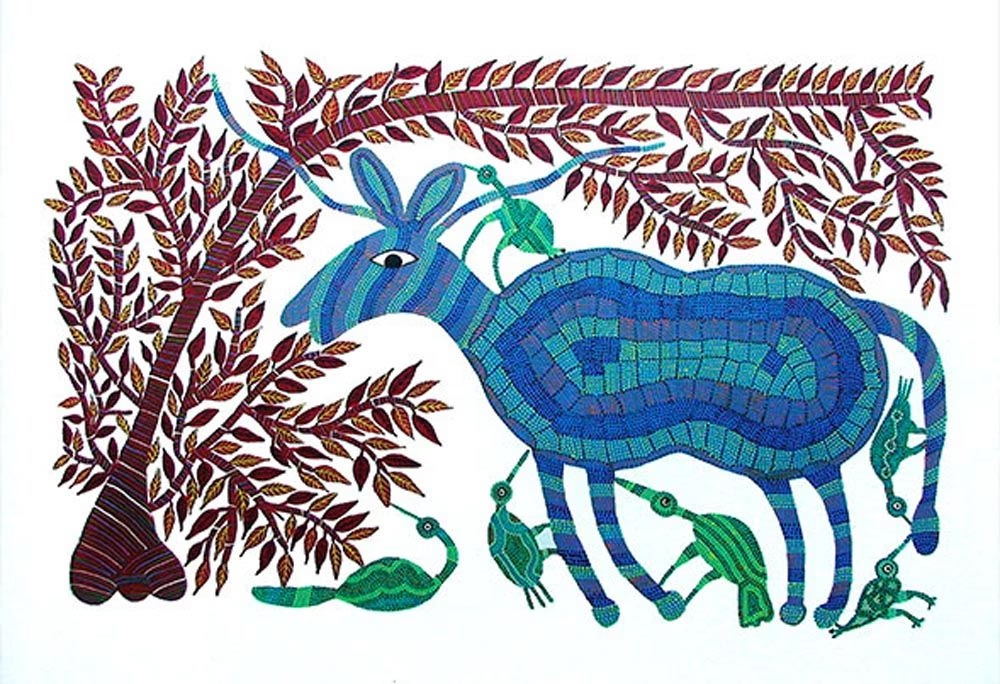
At the heart of Bhil Art lies symbolism, and believe me, these dots aren’t just decoration; they’re storytellers. Each tiny dot is like a word, and together they create a whole language of visuals. Animals, trees, and natural elements are drawn with meanings that connect to tribal life and beliefs.
- Dots as energy – Every dot represents a prayer, blessing, or connection to nature. Think of them as Wi-Fi signals to the spiritual world.
- Animals as protectors – Tigers stand for strength, birds symbolize freedom, and deer reflect peace and grace.
- Nature as life-giver – Trees are often painted as the “Kalpavriksha” (wish-fulfilling trees), showing how deeply the Bhils respect forests.
- Colors with emotions – Red for fertility, yellow for happiness, and green for prosperity. Yes, their palette has more meaning than our emoji reactions!
Traditional Themes and Their Cultural Meanings
The themes in Bhil Art go beyond pretty patterns; they reflect real tribal life. Artists often paint festivals, farming scenes, rituals, or even stories of gods and ancestors. Each theme is like a visual WhatsApp status update from centuries ago!
- Festivals and rituals – Paintings of celebrations like Navratri and Diwali show community spirit.
- Farming and harvest – Crops and fields reflect gratitude for food and nature’s gifts.
- Mythology – Gods, legends, and folktales appear to connect the tribe with its roots.
- Community stories – Everyday life, like fishing, hunting, or dancing, remind us that art and life are inseparable.
Bhil Art is more than decoration; it’s culture, history, and emotion packed into colorful dots. No wonder designers today are bringing it onto canvas bags, fashion wear, and even home décor.
From Mud Walls to Moving Canvases
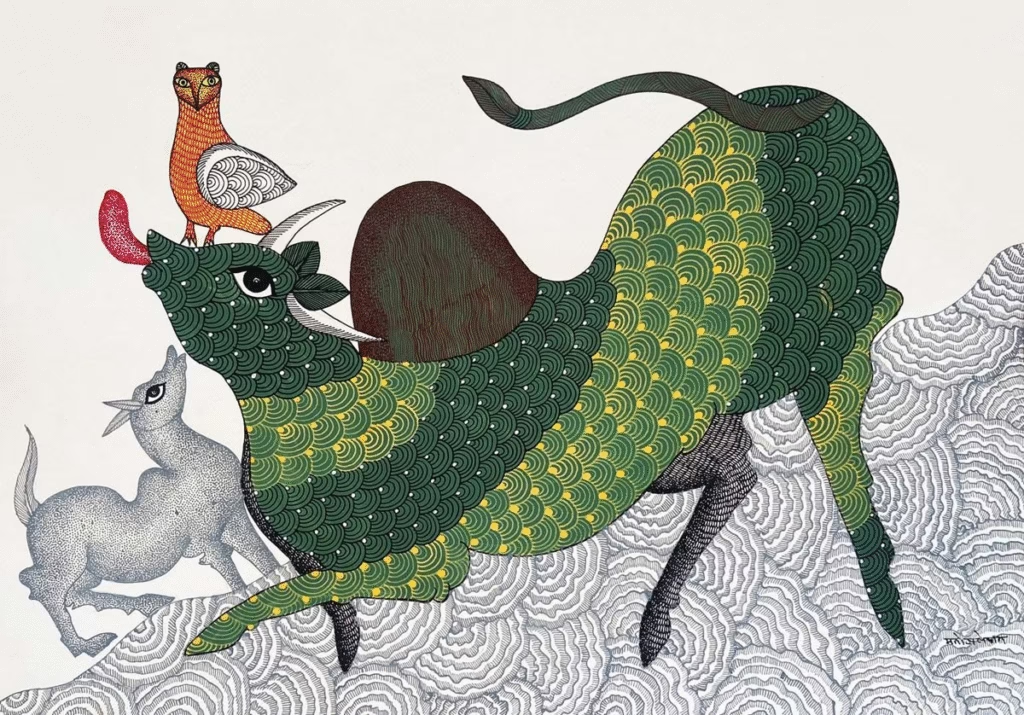
Bhil Art has always been more than just pretty dots on walls; it’s a living language of stories. Imagine this: centuries ago, villagers painted on mud walls and caves, telling tales of animals, harvests, and gods, all with those famous dots. Fast forward to today, and the same art has traded walls for tote bags, diaries, coffee mugs, and even mobile covers. Yes, your morning cup of chai could now be decorated with a deer made of dots!
What started as an expression of daily life has now turned into a movement that blends heritage with modern lifestyle. According to a 2023 survey on tribal art markets, more than 58% of Bhil artworks sold today are on usable objects rather than traditional surfaces. That’s proof that art doesn’t just sit in museums; it walks with us. Bhil Art has truly gone from being a “village storyteller” to a “global trendsetter.”
How Bhil Art Shifted from Walls and Caves to Everyday Objects
The journey of Bhil Art is nothing short of magical. Once found on walls and caves, it has now spilled into objects we use every day. Why should only walls enjoy the beauty, right?
- From mud to mugs: Those dots that once adorned huts now jazz up coffee mugs and tea cups.
- From caves to canvas bags: Imagine carrying your groceries in a tote bag that literally carries 1,000 years of tradition.
- From festivals to furniture: Once only used for rituals, today you can spot Bhil designs on furniture, cushion covers, and even lampshades.
This shift keeps the art alive while making it relatable for the next generation. It’s like giving history a wardrobe makeover; it still has the same soul but looks trendier!
The Role of Artisans in Preserving This Heritage
Behind every modern Bhil Art mug, bag, or diary, there’s an artisan keeping centuries of storytelling alive. They aren’t just painters; they’re memory-keepers.
- Passing the brush: Families pass down techniques, ensuring dots don’t fade with time.
- Adapting without losing roots: Artisans balance tradition with modern demand; painting deer on laptop sleeves instead of cave walls.
- Economic empowerment: According to a tribal craft report, over 42% of Bhil artisans earn a steady income today by selling contemporary pieces, making heritage their livelihood.
So next time you buy a Bhil Art notebook, remember, you’re not just buying stationery; you’re buying centuries of stories, laughter, and dots!
Bhil Art Meets Fashion: The Rise of Canvas Bags
Once upon a time, Bhil Art lived happily on mud walls, telling stories of nature, animals, and village life with dots and patterns. Fast forward to today, and those same vibrant dots have found a new home; on trendy canvas bags! Yes, Bhil Art has gone from rural walls to city streets, swinging from shoulders in the form of chic and eco-friendly totes.
But why canvas, you ask? Well, because fashion isn’t just about looking good anymore; it’s about feeling good, too. And nothing says guilt-free shopping like carrying a bag that’s sustainable, stylish, and deeply rooted in cultural heritage. According to a survey, about 67% of millennials prefer eco-friendly products, and canvas happens to be the poster child of “green fashion.” Add to that the rising love for handmade and artisanal crafts, and you’ve got a recipe for bags that are not just accessories but little moving art galleries.
Why Designers Chose Canvas as a Sustainable Medium
Canvas isn’t just your old-school cloth used for sails and tents—it’s fashion’s new best friend. Designers love it because:
- Eco-friendly choice – Unlike plastic, canvas is reusable and biodegradable.
- Durable and strong – These bags can handle grocery hauls and laptops without giving up midway.
- Perfect painting surface – The texture is like a blank diary page for Bhil artists to let their dots dance freely.
- Affordable luxury – You don’t need celebrity budgets to flaunt culture and sustainability together.
Fun fact: The global eco-bag market is growing at nearly 6% every year, and canvas bags are leading the charge. So, the next time someone asks, “Paper or plastic?” you can proudly say, “Neither, I’ve got Bhil Art on canvas!”
How These Bags Blend Tradition with Utility
Here’s where the real magic happens; style meets substance. These bags are:
- Functional – From carrying books to beach towels, they do it all.
- Fashionable – Tribal dots + modern cuts = runway-ready.
- Cultural carriers – Each bag tells a story, keeping Bhil Art alive in daily life.
- Conversation starters – Trust us, people will ask, “Where did you get that bag?”
In short, Bhil Art canvas bags are not just bags; they’re walking museums with zippers!
From Local Markets to Global Boutiques
Once upon a time, Bhil Art was something you’d only spot on mud walls in tribal villages or maybe on a handmade basket at a local fair. Fast forward to today, and you’ll find the same dotted magic displayed in exhibitions, showcased on fashion week ramps, and yes; even trending in online boutiques with international buyers clicking “add to cart.” What used to be simple art for storytelling has now turned into a fashion statement, painted proudly on canvas bags.
The rise of eco-friendly fashion has given Bhil-inspired bags a global passport. According to a 2024 report on sustainable accessories, nearly 57% of urban buyers prefer handmade or hand-painted products over machine-made ones. And let’s be honest; who doesn’t want to carry a bag that tells a story instead of just holding groceries? From New York to Nagpur, these dotted designs are making fashionistas smile, proving that culture and chic can go hand in hand (or should we say, hand in bag?).
The Role of Exhibitions, Fashion Weeks, and Online Stores
Exhibitions have played a massive role in taking Bhil Art from rural corners to city boutiques. Art fairs, cultural festivals, and design expos act like launchpads for these tribal designs. Fashion weeks take it a notch higher by letting models walk the ramp with Bhil-inspired canvas bags, making them look like walking art galleries. Online stores then close the loop, making these designs accessible to anyone with Wi-Fi and a credit card.
- Exhibitions: Create awareness and bring tribal artists closer to urban audiences.
- Fashion weeks: Turn Bhil Art into “must-have” accessories with a glam touch.
- Online stores: Make it global; because why should Paris or Tokyo miss out on Indian tribal magic?
Celebrities and Influencers Endorsing Bhil-Inspired Bags
When a Bollywood diva or an Instagram influencer is spotted flaunting a Bhil Art canvas bag, you know it’s more than just “tribal chic.” Celebrities add that sparkle, while influencers make it relatable for everyday use. And trust me, nothing sells faster than when your favorite star casually posts, “Obsessed with my new hand-painted bag.”
- Celebs: Bring mass visibility; if Deepika carries it, the world wants it.
- Influencers: Create trust by styling Bhil Art bags in everyday outfits.
- Stat check: Around 72% of young buyers admit they bought a fashion product because they saw a celeb or influencer endorsing it.
Preserving Tradition While Inspiring Innovation
Bhil Art is more than just dots, colors, and patterns; it’s a living tradition passed down from one generation to the next, like grandma’s secret recipe that you dare not alter (unless you want a family debate at dinner!). But while the roots of Bhil Art remain deeply tied to culture and storytelling, the branches are stretching into new territories: fashion runways, designer studios, and even your everyday tote bag. The exciting part? This art form is not just surviving, it’s thriving by finding new audiences across the world.
According to a recent report, the global handicrafts market is expected to grow at over 11% CAGR by 2030, and tribal arts like Bhil painting are catching the spotlight in both traditional and luxury markets. So yes, those little dots painted with love in Indian villages are now making dots (pun intended!) across the globe. The question is; how do we keep this balance between respecting tradition and driving innovation?
Supporting Artisans Through Fair Trade and Collaborations
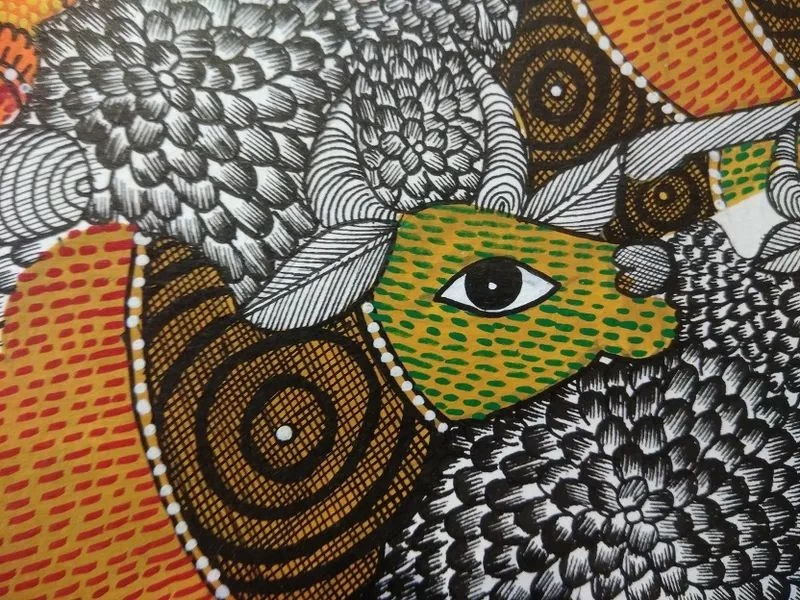
To truly preserve Bhil Art, supporting the artisans is key. After all, without the skilled hands of tribal painters, those magical dots would just remain…dots. Fair trade initiatives ensure that artists get paid fairly for their hard work, and collaborations with fashion designers, NGOs, and even global brands give them the exposure they deserve. Imagine buying a handbag where the label proudly says “Made by Bhil Artisans” instead of “Made in China.” Feels good, right?
- Fair pay matters: Studies show that nearly 68% of artisans in India earn below minimum wage, which fair trade programs aim to change.
- Collabs = exposure: Big names in design are now teaming up with tribal artists, taking their work from village walls to Milan runways.
- Sustainability wins: Hand-painted Bhil Art is eco-friendly, unlike fast fashion prints that fade after two washes.
Fair trade isn’t charity; it’s empowerment with dignity.
Future of Bhil Art in Modern Design and Global Fashion
The future looks as bright as the colors in a Bhil painting. With growing interest in authentic, handmade, and sustainable fashion, Bhil Art is ready to shine on the global stage. Young designers are already experimenting with Bhil motifs on jackets, sneakers, and even tech accessories (yes, your phone cover can carry tribal vibes!).
- Global trend: The ethical fashion industry is projected to hit $15 billion by 2030, and Bhil Art fits perfectly into this wave.
- Youth appeal: Minimalist yet cultural designs are gaining traction with Gen Z and millennials, who value both style and story.
- Digital boost: Social media platforms are helping Bhil artisans sell directly to buyers, cutting out middlemen.
Who knows, in a few years, we might see Bhil Art-inspired sneakers trending on TikTok or a celebrity rocking a Bhil-painted jacket at the Met Gala. Tradition, with a dash of innovation, is the perfect recipe for making Bhil Art immortal.
Final Takeaway
Bhil Art is not just painting; it’s storytelling with dots, colors, and culture. From village walls to canvas bags in designer boutiques, this art has traveled a long way while keeping its roots alive. The best part? Every Bhil Art piece is more than just a design; it’s a little history lesson you can carry on your shoulder or hang on your wall.
In today’s world, where fast fashion comes and goes, Bhil Art stands strong as a reminder that tradition never goes out of style. With fair trade, collaborations, and growing global love for sustainable fashion, Bhil artists are finally getting the stage they deserve. According to reports, handmade crafts like these are becoming a favorite among young buyers worldwide, and that’s a trend worth celebrating.
So, the next time you see a Bhil Art canvas bag, don’t just think “fashion.” Think of it as carrying centuries of tradition with a modern twist!
Visit our Traditional Art Blog to read them all in a simple, fun way.

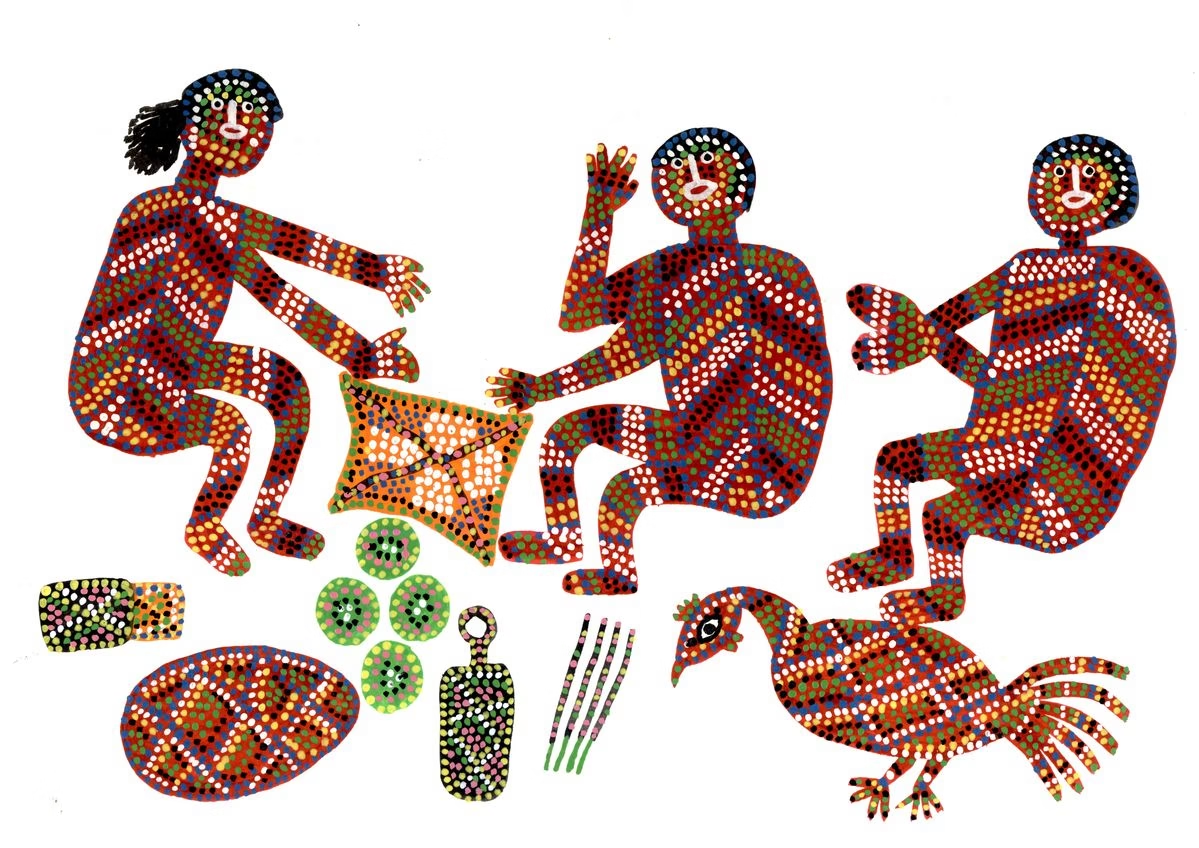
Leave a Reply